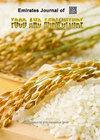甘蔗浓度对番茄酱泡沫垫干燥动力学及理化性质的影响
IF 0.7
4区 农林科学
Q3 AGRONOMY
引用次数: 1
摘要
研究了甘蔗用量和发泡工艺对意大利面酱发泡性能、干燥动力学和物理化学性能的影响。在选定的甘蔗浓度(0、15和30%的糖/g浓缩番茄)和60℃的恒定干燥温度下,对基于番茄的非发泡和发泡意大利面酱进行了干燥实验。结果表明,发泡意大利面酱汁的密度和粘度低于非发泡意大利面酱料,从而提高了干燥速率。甘蔗浓度越高,意大利面酱的密度和粘度就越高,导致干燥速度较慢。佩奇模型被认为是描述意大利面酱干燥动力学的最佳模型。发泡过程和降低甘蔗浓度通常会降低最终水分和蔗糖含量、水活性、水溶性指数和吸湿性。此外,它们还增加了蛋白质含量、吸水指数和干意大利面酱的颜色。考虑到番茄酱的干燥速度和理化性质,我们提出了发泡工艺和低糖浓度生产番茄酱。关键词:干燥动力学;发泡工艺;意大利面酱粉;甘蔗本文章由计算机程序翻译,如有差异,请以英文原文为准。
The effect of sugar cane concentration on foam-mat drying kinetics and physicochemical properties of dried-tomato pasta sauce
We investigated the effect of sugar cane level and foaming process on the foaming properties, drying kinetics, and physicochemical properties of dried pasta sauce. Experiments were conducted on drying pasta sauce based on tomatoes, both non-foamed and foamed, at selected sugar cane concentrations (0, 15, and 30% g sugar/g concentrated tomato) and a constant drying temperature of 60.C. The results indicated that the density and viscosity of foamed pasta sauce were lower than that of non-foamed pasta sauce, thereby increasing the drying rate. The higher the sugar cane concentration, the higher the density and viscosity of pasta sauce, resulting in a slower drying rate. The Page model was found as the best model to describe the drying kinetics of pasta sauce. The foaming process and reducing sugarcane concentration generally decreased the final moisture and sucrose content, water activity, water solubility index, and hygroscopicity. Moreover, they increased protein content, water absorption index, and the color of dried pasta sauce. Considering the drying rate and physicochemical properties, we proposed the foaming process and less sugar concentration to produce dried-tomato pasta sauce.
Keywords: Drying kinetics; Foaming process; Pasta sauce powder; Sugar cane
求助全文
通过发布文献求助,成功后即可免费获取论文全文。
去求助
来源期刊

Emirates Journal of Food and Agriculture
AGRONOMYFOOD SCIENCE & TECHNOLOGY&nb-FOOD SCIENCE & TECHNOLOGY
CiteScore
1.80
自引率
0.00%
发文量
18
期刊介绍:
The "Emirates Journal of Food and Agriculture [EJFA]" is a unique, peer-reviewed Journal of Food and Agriculture publishing basic and applied research articles in the field of agricultural and food sciences by the College of Food and Agriculture, United Arab Emirates University, United Arab Emirates.
 求助内容:
求助内容: 应助结果提醒方式:
应助结果提醒方式:


